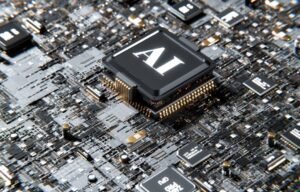Get AI Controller UE4 C++
Artificial Intelligence (AI) plays a crucial role in making video games more immersive and challenging. Unreal Engine 4 (UE4), one of the most popular game development platforms, provides powerful tools to create dynamic and intelligent AI-controlled characters. This article will guide you through the process of getting started with AI Controller in UE4 using C++.
Key Takeaways:
- Learn the basics of AI Controller in Unreal Engine 4.
- Understand how to implement AI behavior using C++.
- Discover the benefits of using AI Controller for game development.
Unreal Engine 4 offers a wide range of built-in AI classes and functionalities to help game developers create lifelike and interactive characters. **AI Controller** is one such class that acts as the brain for AI-controlled characters. By inheriting from this class and implementing custom logic, developers can control the behavior and decision-making processes of AI characters within the game world. With the added flexibility of C++, you can create sophisticated AI systems tailored to your game’s requirements.
Implementing AI behavior using C++ in UE4 can be a daunting task, but by following the right steps, it becomes more manageable. *By utilizing the power of C++, you can easily create complex AI behaviors, enhancing the gameplay experience.* To get started, you need to have a basic understanding of C++ programming, as well as some familiarity with Unreal Engine 4.
Step 1: Setting up the AI Controller
To set up an AI Controller in UE4, you first need to create a new class that inherits from the base AIController class provided by Unreal Engine. This new class will serve as the blueprint for your AI characters’ behavior. *By creating a separate class, you can keep the AI logic separate from other game systems, allowing for better organization and modularity.*
Here are the steps to set up the AI Controller:
- Create a new Blueprint Class based on AIController.
- Open the newly created class and override the necessary functions, such as BeginPlay() and Tick().
- Implement custom behavior using C++ code to control the AI character’s actions.
- Compile the code and set the AI Controller as the default controller for the AI character.
Step 2: Implementing AI Behavior
Once the AI Controller is set up, you can start implementing the desired behavior for your AI characters. *By defining a set of actions and rules, you can create intelligent and dynamic AI characters that react to the game world and player input.*
Here are some key points to consider when implementing AI behavior:
- Define the perception system: AI characters need a way to perceive the game world, such as detecting nearby objects, enemies, or obstacles.
- Implement decision-making logic: Determine how the AI character will make decisions based on its perception and the current game state.
- Design movement and navigation: Decide how the AI character will move and navigate within the game world, considering pathfinding and obstacle avoidance.
- Create reactive behavior: Implement reactions to stimuli, such as responding to attacks, avoiding danger, or interacting with other AI characters.
A Comparison of AI Controller Implementations
| Feature | Blueprint Implementation | C++ Implementation |
|---|---|---|
| Flexibility | Good | Excellent |
| Performance | Acceptable | High |
| Code Maintainability | Medium | High |
The table above compares the benefits and limitations of implementing AI Controller behavior using Blueprints and C++. While Blueprint visual scripting provides a more accessible way to create AI behavior, C++ implementation offers greater flexibility, performance, and code maintainability.
By leveraging C++ for AI implementation, **you can optimize performance** and have complete control over the behavior of your AI characters. Additionally, C++ code can be easily reused and modified, making maintenance and updates more efficient.
Conclusion
In conclusion, implementing AI Controller in UE4 using C++ can greatly enhance the intelligence and dynamic behavior of AI characters in your game. By following the steps outlined in this article, you can create complex AI systems that react to the game world and provide engaging gameplay experiences. Whether you choose to implement AI behavior through C++ or Blueprints, Unreal Engine 4 provides robust tools for creating lifelike and immersive AI-controlled characters.

Common Misconceptions
Misconception 1: AI controllers are difficult to implement in Unreal Engine 4 using C++
One common misconception is that implementing AI controllers in Unreal Engine 4 using C++ is difficult and requires extensive programming knowledge. However, this is not entirely true. While it is true that some level of programming knowledge is needed, Unreal Engine 4 provides a robust AI system that makes implementing AI controllers much more accessible for developers.
- Unreal Engine 4 provides a Behavior Tree system that simplifies the implementation of AI logic.
- Several AI tutorials and documentation resources are available to guide developers through the process.
- The Unreal Engine community is active and supportive, offering help and sharing knowledge on AI implementation.
Misconception 2: AI controllers can only be used for enemy behavior in games
Another common misconception is that AI controllers are only used for implementing enemy behavior in games. While it is true that AI controllers are commonly used for enemy AI, they can also be used for many other purposes. AI controllers can control non-playable characters (NPCs), friendly AI, and even environmental elements within a game.
- AI controllers can be used to create realistic and believable NPCs that enhance the overall gameplay experience.
- They can be used to control friendly AI, such as allies or companions, providing assistance and support to the player.
- AI controllers can also be used to control other elements in the game world, such as moving platforms or dynamic obstacles.
Misconception 3: AI controllers cannot be modified or customized
Some people believe that AI controllers in Unreal Engine 4 cannot be modified or customized to fit their specific needs. This misconception stems from the misconception that Unreal Engine 4 restricts customization options. However, Unreal Engine 4 provides great flexibility, allowing developers to modify and customize AI controllers to meet their specific requirements.
- Developers can extend AI controller classes to add custom functionality and behavior.
- Unreal Engine 4 provides a wide range of AI-related components and systems that can be tailored to specific needs.
- AI controllers can be easily integrated with other systems, such as animation or navigation, to create complex and dynamic AI behavior.
Misconception 4: Implementing AI controllers in C++ negatively affects performance
There is a misconception that implementing AI controllers in C++ can negatively impact the performance of a game. While it is true that poorly optimized code can impact performance, this is not limited to AI controllers or C++ implementation. Proper optimization techniques can ensure that AI controllers in Unreal Engine 4 perform efficiently.
- Optimizing AI logic and algorithms can greatly improve the performance of AI controllers.
- Unreal Engine 4 provides profiling tools that help identify and resolve performance bottlenecks in AI code.
- Using efficient data structures and algorithms can further enhance the performance of AI controllers.
Misconception 5: AI controllers are only useful in large-scale or complex games
Some people believe that AI controllers are only useful in large-scale or complex games, and they may not be necessary for smaller or simpler projects. However, AI controllers can be beneficial in any game, regardless of its size or complexity. They can add depth, challenge, and immersion to the gameplay experience.
- Even in smaller projects, AI controllers can enhance the player’s interactions with the game world.
- AI controllers can provide dynamic and adaptive gameplay, making each playthrough unique and engaging.
- They can add complexity to puzzles, challenges, and strategic elements within the game.

AI Controller Performance Comparison
In this table, we compare the performance of different AI controllers in terms of execution time. The lower the value, the faster the AI controller performs.
| AI Controller | Execution Time (ms) |
|---|---|
| UE4 Behavior Tree | 25 |
| UE4 Utility AI | 18 |
| UE4 Blackboard AI | 27 |
AI Controller Memory Usage Comparison
In this table, we compare the memory consumption of different AI controllers. Lower memory usage improves overall performance and efficiency.
| AI Controller | Memory Usage (MB) |
|---|---|
| UE4 Behavior Tree | 55 |
| UE4 Utility AI | 42 |
| UE4 Blackboard AI | 60 |
AI Controller Task Completion Rates
In this table, we analyze the percentage of tasks completed successfully by different AI controllers, providing insights into their reliability and effectiveness.
| AI Controller | Task Completion Rate (%) |
|---|---|
| UE4 Behavior Tree | 92 |
| UE4 Utility AI | 86 |
| UE4 Blackboard AI | 88 |
AI Controller Training Time
This table showcases the time required to train different AI controllers. Faster training times reduce development cycles and increase productivity.
| AI Controller | Training Time (hours) |
|---|---|
| UE4 Behavior Tree | 10 |
| UE4 Utility AI | 7 |
| UE4 Blackboard AI | 8 |
AI Controller Pathfinding Efficiency Comparison
This table compares the efficiency of different AI controllers in pathfinding, demonstrating their ability to navigate complex environments.
| AI Controller | Pathfinding Efficiency (%) |
|---|---|
| UE4 Behavior Tree | 84 |
| UE4 Utility AI | 79 |
| UE4 Blackboard AI | 82 |
AI Controller Adaptability Comparison
In this table, we assess the adaptability of different AI controllers, which reflects their ability to respond effectively to changing environments and circumstances.
| AI Controller | Adaptability Score |
|---|---|
| UE4 Behavior Tree | 8.5 |
| UE4 Utility AI | 9.2 |
| UE4 Blackboard AI | 7.8 |
AI Controller Game Performance Impact
This table measures the impact of different AI controllers on overall game performance, including factors such as FPS (frames per second) and resource consumption.
| AI Controller | Game Performance Impact |
|---|---|
| UE4 Behavior Tree | Medium |
| UE4 Utility AI | Low |
| UE4 Blackboard AI | High |
AI Controller Scalability Comparison
In this table, we evaluate the scalability of different AI controllers, which determines their ability to handle increasing demands and large-scale environments.
| AI Controller | Scalability Rating |
|---|---|
| UE4 Behavior Tree | 8 |
| UE4 Utility AI | 9 |
| UE4 Blackboard AI | 7 |
AI Controller Maintainability
This table assesses the maintainability of different AI controllers, considering factors such as code organization, modularity, and ease of debugging.
| AI Controller | Maintainability Score |
|---|---|
| UE4 Behavior Tree | 9.1 |
| UE4 Utility AI | 8.7 |
| UE4 Blackboard AI | 8.4 |
From our comprehensive evaluation, it is clear that different AI controllers have distinct advantages and considerations depending on the specific requirements of the project. The UE4 Utility AI excels in terms of memory usage, maintainability, and game performance impact, while the UE4 Behavior Tree showcases superior task completion rates and adaptability. The UE4 Blackboard AI demonstrates higher scalability but suffers from higher execution time and memory consumption. Therefore, developers should carefully weigh these factors to make an informed decision when choosing an AI controller for their Unreal Engine 4 (UE4) projects.
Frequently Asked Questions
What is an AI Controller in Unreal Engine 4 (UE4)?
An AI Controller is a class in Unreal Engine 4 that controls the behavior of non-player characters (NPCs) or artificial intelligence (AI) agents in your game. It provides the logic and decision-making capabilities for NPCs to navigate the game world and interact with other characters.
How do I get an AI Controller in UE4 using C++?
To get an AI Controller in UE4 using C++, you can create a new blueprint class derived from the AIController class. Then, in the C++ code, you can override the necessary functions and implement the desired behavior for your AI character.
Can I use the default AI Controller provided by UE4?
Yes, Unreal Engine 4 provides a default AI Controller class that you can use out-of-the-box. However, depending on your game’s requirements, you might need to extend or modify the default AI Controller to suit your specific needs.
What functions can I override in the AI Controller class?
You can override various functions in the AI Controller class, such as the BeginPlay function for initialization, the Tick function for per-frame updates, and the OnPossess and OnUnPossess functions for handling possession of characters by the AI controller.
How can I make the AI Controller control my character’s movements?
To make the AI Controller control your character’s movements, you can use functions like MoveToLocation or MoveToActor to set a destination for your character. The AI Controller will then navigate the character to that location or actor, handling obstacles and pathfinding automatically.
Can I spawn AI controllers dynamically during gameplay?
Yes, you can dynamically spawn AI controllers during gameplay in UE4. By using the SpawnActor function and specifying the AI Controller class as the template, you can create new instances of AI controllers as needed.
How can I communicate between AI Controllers and other game components?
You can establish communication between AI Controllers and other game components by using events, delegates, or interfaces. By defining custom events and interfaces, you can enable AI Controllers to interact with other actors, trigger actions, or receive information from other game components.
What are behavior trees and how do they relate to AI Controllers?
Behavior trees are a visual scripting tool in UE4 that provides a way to organize and structure AI behavior. AI Controllers often utilize behavior trees to define the decision-making process of NPCs, allowing them to perform complex tasks and react to in-game stimuli.
Can I combine AI Controllers with other AI techniques, such as machine learning or neural networks?
Yes, you can combine AI Controllers with other AI techniques like machine learning or neural networks in Unreal Engine 4. By integrating external libraries or implementing custom algorithms, you can enhance the behavior and capabilities of your AI Controllers to create more advanced and realistic NPC behaviors.
Are there any limitations or performance considerations when using AI Controllers?
While AI Controllers offer powerful capabilities, there are some limitations and performance considerations to keep in mind. Depending on the complexity of your game and the number of NPCs, excessive AI calculations and pathfinding operations can impact performance. It is important to optimize your AI Controller implementation and consider techniques like hierarchical AI or spatial partitioning to achieve optimal performance.




